The most dedicated aquarium owners know that good filtration is essential to having a healthy tank, and aren’t likely to skimp on quality for any reason. You’ve probably tried several different brands of top canister filters, and owned a few good canister filters over the years, but are still curious as to which is the best canister filter.
Quick Comparisons of The 5 Best Canister Filters
| IMAGE | BRAND | DETAILS | |
|---|---|---|---|
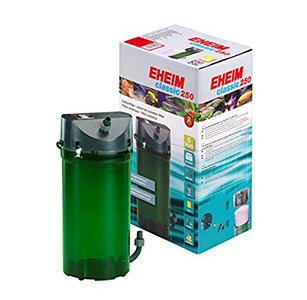 | Eheim Classic Canister Filter |
| View On ChewyView On Amazon |
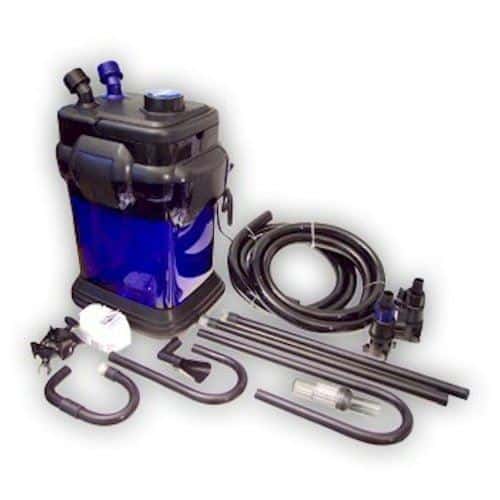 | Penn Plax Cascade 1000 |
| View Product |
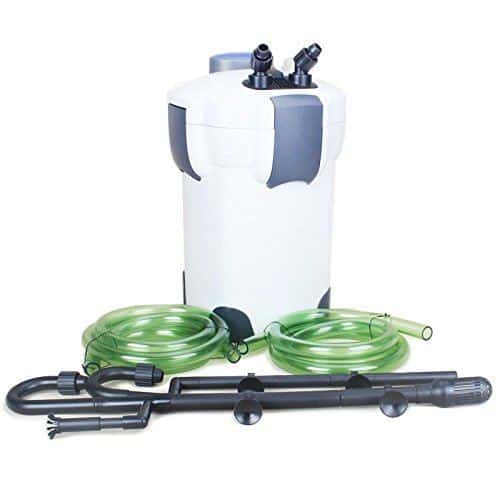 | SunSun HW304B |
| View On ChewyView On Amazon |
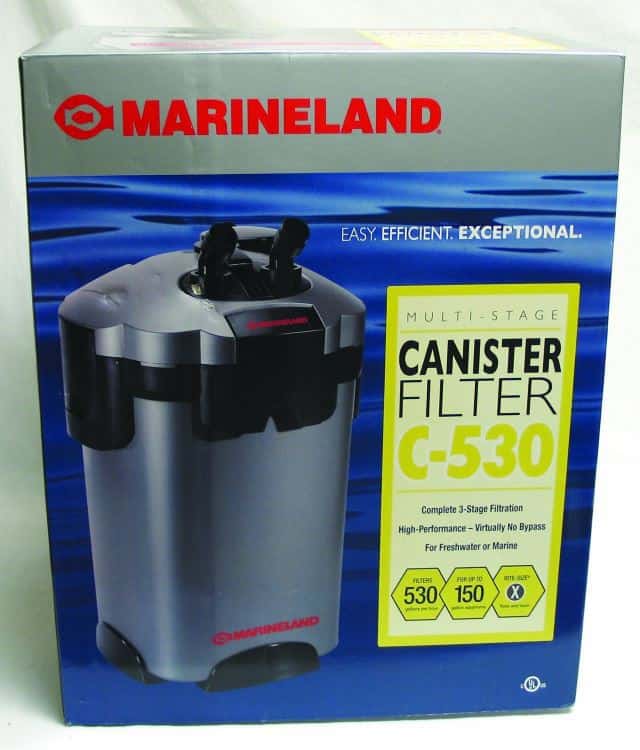 | Marineland C-530 |
| View On ChewyView On amazon |
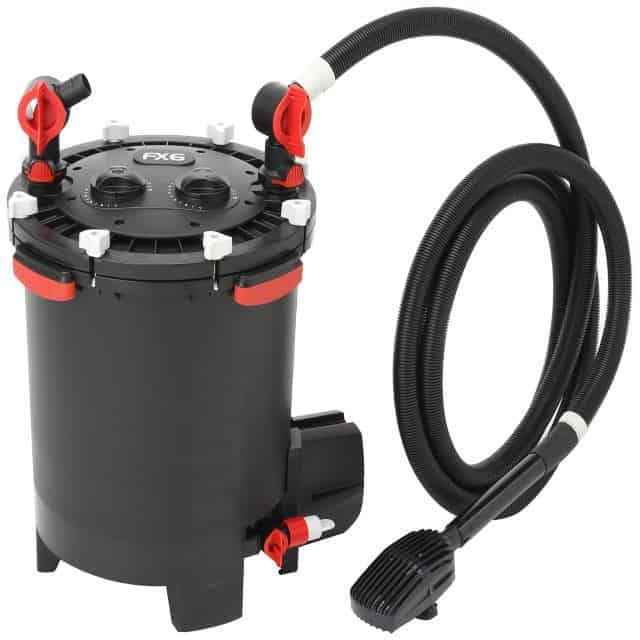 | Fluval FX6 |
| View Product |
I’d be lying if I said I wasn’t curious myself, so I’ve decided to do a bit of homework, compile some canister filter reviews, and finally get to the bottom of the ongoing question, “Which canister filter is the best canister filter for fish tanks?” Before diving right into the contenders, though, it might be wise to do a quick refresher on some of the finer points of what filtration is and what a tank owner should be looking for in a filter.
What Is A Canister Filter?
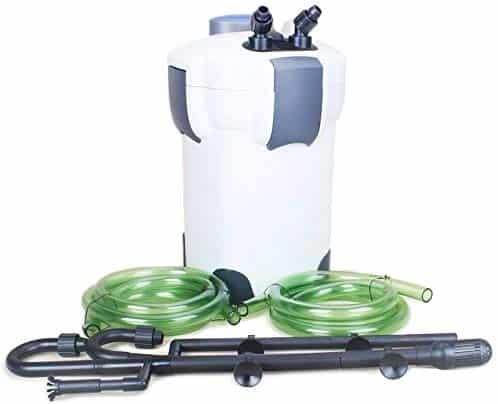
Even newcomers to fish ownership have probably seen some simple filtration units before and know that they are used to keep aquarium water clean by filtering out waste and debris. Canister filters are heavy-duty filters designed for larger tanks with more fish in them. They can be used in saltwater or freshwater, and have larger canister-shaped bodies that fit outside of a tank as opposed to inside the tank.
Because of their large size, canister filters can pass much larger amounts of water through them than basic air-driven internal filters or under gravel filters, and get the water looking much cleaner as well. They cost a bit more than your average filter, with only Wet/Dry filters being more expensive. They also take a bit more effort regarding setup and maintenance. They get the job done, though; you can see one in action below.
Canister filters often require an involved setup process, without the benefit of clear instructions. They also need their owner to carry them to the sink and disassemble them to clean their components individually. This task can be particularly burdensome for owners with large filters that are stuffed to the brim with cleaning mediums.
How Does A Canister Filter Work?
Particulars can vary, but at the least, most canister filters make use of a process known as 3-stage filtration. Water from the tank is sucked through hoses and then passed through a series of steps that treat it in different ways to clean it: Mechanical, Biological, and Chemical.
Mechanical filtration is the most basic and involves only removing solid materials from the water. This can include tiny particles of plant debris, uneaten food, and fish waste. A canister filter’s internal mechanical filter acts a sieve that strains the water, capturing the unwanted materials. On its own this step can leave water clean, but to have truly healthy water more is required.
The second form of filtration, Biological filtration, uses biological media to reduce the levels of toxic components like ammonia. Various surfaces are used to promote the growth of beneficial bacteria that consume these unwanted compounds and produce less toxic by-products that are safer for your fish.
Chemical filtration, generally the last step, involves the direct injection of various chemicals to remove aquarium impurities. These include things that can be harmful to fish and aquatic plant life, like excess protein, dissolved metals, chlorine, medication, and everyday tap water impurities.
Once the water has passed through these stages, it is pumped back into the tank with a second hose. This has the dual benefit of creating an influx of clean water for your fish, and generating currents that keep water in the tank from becoming stagnant. Many canister filters have adjustable hoses and filtration rates, along with accessories called spray bars, so that you can have direct control over how the tank water is stimulated.
It is important to note that some filters also include additional features that help to clean the water. One of the most popular is the UV filter, which uses UV light to purify the water, much as a water treatment plant would. These UV lights increase a filter’s power draw, naturally, but are very efficient at getting water even cleaner than just using 3-stage filtration.
What Are Filter Media?
These do the actual job of cleaning your tank water. There are many varieties for each stage, but the main ones you’ll need to keep in mind are Filter Pads and Floss (mechanical), Ceramic Rings and Bio-Balls (biological), and Activated Carbon (chemical). More advanced canister filter users believe that mixing media is important and will also employ things like Ion Exchange Resins, Phosphate Absorbing Media, and Protein Skimmers further to optimize the cleanliness of their tank water.
What Size Canister Filter Do You Need?
The sizes are different, but a good rule of thumb is the bigger your tank, the bigger your filter. You might want to consider obtaining a canister filter with ratings that are beyond the tank that you own since the actual capacity and flow rate dip somewhat when a filter is fully loaded with all of its filter media. A larger, more powerful filter is also a benefit since it will achieve greater water cleanliness.
The downside is that bigger filters are often heavier and take up more space. If you have a limited amount of room around your tank, or you aren’t keen on lugging 20+ pounds back and forth to the sink, you may want to consider going smaller and lighter.
Top 5 Aquarium Canister Filter Reviews
Eheim Classic Canister Filter

- 1-year warranty
- 4.5 pounds
- 66-gallon capacity
- 116 gph flow rate
The Eheim Classic is, as the name suggests, a member of filter manufacturer Eheim’s “classic” line of canister filters that have a tried-and-true cylindrical design. This particular model, the 2213-37, is a base version, useful for handling tanks up to 66 gallons. It has a pump output of 116 GPH, circulation rate of 102 GPH, a power consumption of 8 watts, and total filter volume of ¾ gallons.
Regarding size, this model is on the smaller side, measuring 14 inches high, and weighing only 4.5 pounds. This filter comes packed with Ehfisynth, Ehfisubstrate, Ehfifix, and Ehfimech filtration media. These are all Eheim branded media, so there are no compatibility issues with using them, and the Ehfisubstrate, in particular, is known for providing a large surface area for beneficial bacteria to grow.
This Eheim filter is known for its one-chamber design, which allows users to customize how much of each type of filter media they want in the filter, separating the media into layers using supplied Eheim Filter Pads. The compact design is known for being quiet and efficient, but this filter is somewhat underpowered when compared to some of the larger models available. Still, if your setup is on the smaller side, this might just be the optimal canister filter for 55-gallon aquariums.
PROS
- Small
- Quiet
- One chamber design
CONS
- Not as powerful
Penn Plax Cascade 1000

- 3-year warranty
- 12 pounds
- 100-gallon capacity
- 265 gph flow rate
The Penn Plax Cascade was designed as a middle of the road heavy duty model that balances price and performance. It can handle 100-gallon aquariums and delivers a 265 GPH flow rate. This filter features a big boxy, yet sturdy design that incorporates the standard 3 stage filtration process, but has some features aimed at ease of use for beginner tank owners. This includes an easy self priming system (just push a button and you’re good to go), along with 360-degree rotating valve caps, and a variable flow rate from the quick-disconnect cut-off valves.
Concerning size, this model is also average. It has a total height of 17 inches and weighs about 12 pounds. The Penn Plax is quiet and durable, but only has two filter trays, which gives you slightly limited options regarding setting up your filtration media. Speaking of which, the Penn Plax makes use of the Bio-Sponge for its biological filtration, which doubles as mechanical filtration as well. Water can pass through the sponge, but not solid particles, and the large surface area maximizes area exposure to promote increased bacterial growth.
This is a reliable filter for those looking for decent power, but who aren’t ready to make a huge monetary investment. It might even be the best canister filter for 100-gallon aquariums, but it’s probably not the best canister filter overall, on account of its reduced media storage and lower stats in comparison to the more powerful filters on the market.
PROS
- Balanced stats
- Good for beginners
- Sturdy construction
CONS
- Small media storage
- Not as powerful
SunSun HW304B

- 1-year warranty
- 14 pounds
- 150-gallon capacity
- 525 gph flow rate
SunSun’s 5-stage external filter is the most powerful they have on the market. Rated for tanks up to 150 gallons, it can really shine when used on 125 gallon aquarium or even something smaller, since it has a high flow rate of 535 GPH. It’s a bigger filter, measuring 11” x 11” x 17”, but light enough (14 pounds) to handle without serious issue.
The HW304B includes 4 large media trays, fit for the addition of plenty of activated carbon, ceramic rings, bio-balls, or whatever other filtration media strike your fancy. None of these, unfortunately, come packaged with the unit. You’ll have to buy them each separately. SunSun did include some filter pads, but they’re not the best around, so you’ll likely have to get some more of those as well.
SunSun provided a few ease-of-use features on this filter, such as a self-priming pump (that doesn’t always work as expected), but the most useful extra by far is the 9-watt UV sterilizer. It increases your unit’s power draw, certainly, but it’s a great method for controlling algae and eliminating many kinds of harmful bacteria.
PROS
- Inexpensive
- Includes UV sterilizer
- High flow rate
CONS
- No media included
Marineland C-530

- 1 year warranty
- 30.5 pounds
- 150 gallon capacity
- 530 gph flow rate
This high-performance filter is easy to assemble, easy to use, and a great choice for tank owners in the 75-125 gallon range. The filter’s max capacity is 150 gallons, and its max flow rate is 530 GPH. You’ll need a fair bit of space to house the C-530 though, as it measures 18.25” x 13.5” x 21.5”, and gets heavy once you have it filled up with all the media you need.
It offers a lot in terms of media storage, with 4 stacked trays that provide individual flow-through and cut down on water bypass. Marineland is also thoughtful enough to include filter floss pads, filter foam, a carbon filter bag, bio-filter balls, and ceramic bio-filter rings with the unit. You’ll be able to assemble and operate this filter right out of the box.
Setup and maintenance are easier in comparison to other models, and the C-530 even comes with an instructional DVD to guide you along. The filter includes a quick prime button so you can get it started easy and quickly, as well as a quick-release valve block that instantly shuts down water flow when it comes time to clean the filter.
PROS
- High flow rate
- No-bypass design
- Durable
- Easy setup
CONS
- Priming pump is thin
- Still spills some when cleaning
Fluval FX6

- 3-year warranty
- 16 pounds
- 400-gallon capacity
- 563 gph flow rate
Fluval is well known for top of the line filters, and the FX6 represents the pinnacle of high-power performance. It can handle 150-gallon aquariums with ease, with a maximum capacity of 400 gallons, and an astounding flow rate of 925 GPH (pump) and 563 GPH (filter). The filter trays are astoundingly roomy, allowing for 1.5 gallons of total media, ensuring the highest level of water purification available. One might think that this would consume an awful amount of energy, but the FX6’s total power consumption is only 43 watts, 10% less energy than its predecessor, the FX5.
Each stage of filtration in the FX6 is designed to nullify any water bypass and is lined with mechanical foam for continued straining of particles from the water. The filter is also equipped with Fluval’s vaunted Smart Pump Technology (SPT). This gives the FX6 superior levels of performance and includes ease-of-use capabilities like monthly reminders that let you know when to clean the filter and change the water. This was especially helpful for me, as I sometimes forget when the last time I cleaned the filter was, and welcome the help in keeping organized.
The FX6 comes with a heftier price tag but is clearly king in terms of overall features, power, versatility, and ability to handle just about any fish tank you could imagine. This isn’t just arguably the best saltwater canister filter on the market; some consider it the best aquarium canister filter period. Provided you’re ready to put up the extra money and time that it will take to set up.
PROS
- Unparalleled capacity and flow rate
- Large filter capacity
- Additional mechanical filtration
- Smart Pump Technology
- Wider range of additional features
CONS
- Pricey
Conclusion
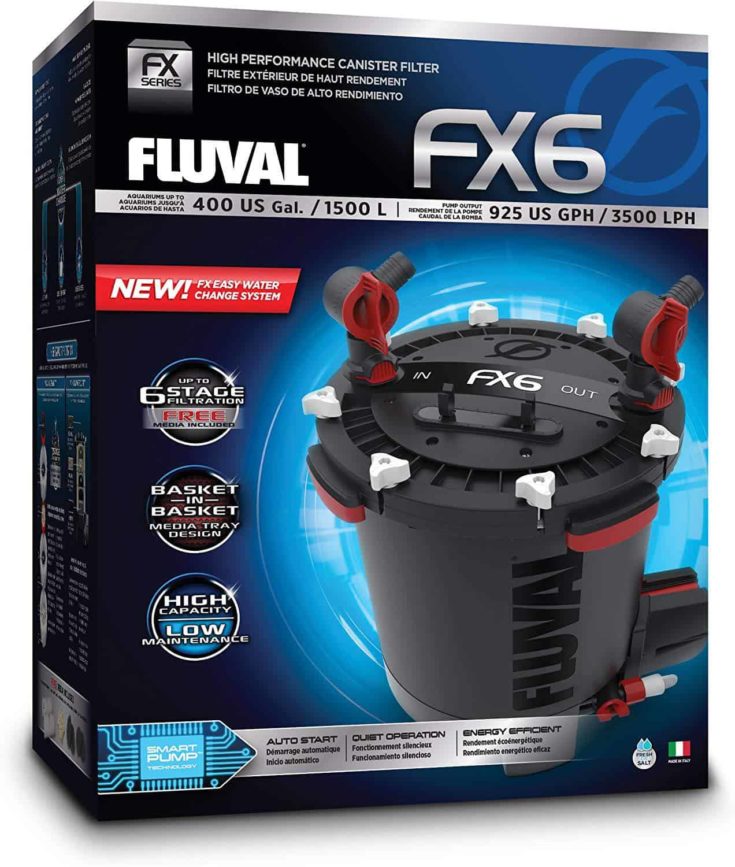
The decision on which filter to buy is going to be dictated mainly by your personal circumstances, but far and away the best canister filter is the Fluval FX6. It combines exceptional power, ease of use, and filtration ability into a package that is smaller, lighter, and less energy consumptive than one might assume. Also, because of its filter capacity, it’s ideal for any tanks that require a good amount of volume, like a turtle aquarium for example.
All of the added features ensure that it operates smoothly and with a small likelihood of failure or leaks. The price is higher than other filters on the market, but that’s only because it delivers so much more. In the end, the Fluval FX6 is the best canister filter your money can buy.
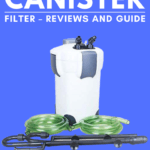
I own 2 FX6’s on a 150 gallon African Cichlid tank and I agree. They are the best. Very powerful and quiet.